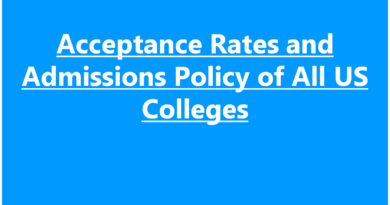UC Berkeley Admissions 2024
University of California (UC) is one of the top rated universities in the US. Every year, over 1 Million students apply for undergraduate admissions to the UC Berkeley and other campuses with over 125,922 applicants only for UC Berkeley. Most of the UC Campuses receive over 100,000 applications each year. UC has nine campuses name Berkeley, Davis, Irvine, UCLA, Merced, Riverside, San Diego, Santa Barbara, and Santa Cruz. UC admission requirements and application deadlines for all the campuses are same. Moreover, you can apply to as many campuses as you like or even all campuses on a single application portal.
It is pertinent to mention here that UC offers admissions twice a year, in Fall semester and Winter Semester. Some of the UC campuses follow quarter system while two campuses follow Semester System. We will discuss the details in the following sections. Also, the deadline for freshmen and Transfer applications is the same.
UC Admissions Deadline 2024
UC Admission deadline for all applications including freshmen and transfer for fall 2023 is November 30, 2023. The deadline of UC Berkeley and all other campuses is the same. All UC applications are to be submitted before midnight 12 AM on November 30th. For those applying from outside the state of California, remember that this is 12 AM Pacific Standard Time (PST).
UC Berkeley Application filing periods 2024
Fall quarter/semester: October 1–November 30
Winter quarter/spring semester: July 1–31
Important Dates
| Application available | August 1 |
|---|---|
| Application filing period | October 1-30 |
| Application deadline | November 30 |
| Apply for financial aid – FAFSA or CA Dream Act applications open | December 1 |
| Berkeley notifies applicants of receipt of application | By Early December |
| Online UC Transfer Application Update (TAU) deadline | January 31 (priority) |
| UC Berkeley mandatory forms deadline | January 31 |
| FAFSA and CA Dream Act Deadline | March 2 |
| First-year decisions posted | End of March* |
| Transfer decisions posted | End of April* |
| First-year deadline to accept offer of admission | May 1 |
| Transfer deadline to accept offer of admission | June 1 |
**Exact decision dates are given to current applicants in confirmation emails and on the student application portal (coming soon).
UC Berkeley and UC Merced are on the semester system calendar while all other campuses are on the quarter system calendar. All campuses are open for the fall term.
You can apply to as many campuses as you like at the online admission application portal of the university at University of California application.
UC Berkeley Required Application Checklist
University of California required checklist of documents and information is listed below. Before filling out the application form for any of the UC campuses, you need to have the following documents and information ready:
- School/Diploma Transcripts: You need to have the transcripts of your score issued by your school ready. Although, the transcripts are not required for filling out the application form, but it will be required if you are admitted to the university.
- Parent’s Annual Income: While filling out the application form, you are required to enter the parent’s annual income. You can ask your parents and fill out the application as per their annual tax returns.
- Social Security Number: Social security number is required for application verification process and is also required if you are apply for financial aid.
- Visa information: If you are not a US citizen, you’ll need to provide your visa info and immigration status.
- California Statewide Student ID: If you have completed your high school qualification from a public school in California, you’ll need to mention it.
- Credit Card: To pay for the application processing fee.
When will UC decisions come out in 2024?
UC Admission decision comes out on March 01. Decision of all freshmen applicants is communicated to the students latest by March 31.
First-Year Student Profile
| Unweighted GPA | 3.89-4.00 |
|---|---|
| Weighted GPA | 4.28-4.62 |
Data points reflect the middle 50% of students in our 2023 admitted class.
UC Berkeley Acceptance Rate 2024
| 2023 Applications | 2023 Admits | Acceptance Rate 2023 | Acceptance Rate 2022 | |
|---|---|---|---|---|
| Total: First-Year | 125,922 | 14,772 | 11.2% | 11.4% |
| From Public Schools | From Rural Schools | Firs Gen |
| 79.0% | 4.49% | 31.4% |
UC Berkeley Transfer Student Profile
| College GPA | 3.62–3.96 |
|---|
Data points reflect the middle 50% of students.
| 2023 Applications | 2023 Admits | 2023 % | 2022 Applications | 2022 Admit | 2022 % | |
|---|---|---|---|---|---|---|
| Total: Transfers | 19,375 | 5,642 | 29.1% | 19,392 | 5,268 | 27.0% |
| From CCCs | Re-Entry | First-Gen |
| 91.6% | 12.6% | 43.8% |
Who Gets Into UC Berkeley?
Most of the candidates were from California. Out of all the admitted students, 74% were residents of California.
UC Admitted students’ Nationality: Amongst the International Students, Chinese students outnumbered every other nationality, followed by South Korea, India, Canada and Indonesia.
UC Admissions Gender Ratio: Female outnumber male students, with 54% admitted students being female and 46% were male.
According to the UC Berkeley Admissions statistics from the last year admitted students, 791% were from Public Schools, 4.49% students were from rural areas and 31.4% students were First-Generation students. A first-generation student is the one whose parent(s) did not complete a 4-year college or university degree.


